We’re not a totally zero-waste household—something to strive for!—, but James and I have adopted a number of habits that have us reducing the amount of waste that we produce and this year we’re striving to do even better. Because, we can do better. And while we might not all have the power to reverse climate change and stop the oceans from rising, we can definitely take steps to living more lightly and being less wasteful.
In case saving the one precious habitable planet in the solar system isn’t incentive enough, consider this: all of these resolutions have a ripple effect on the environment within our homes. Less plastic, less garbage, less packaging means a home that feels lighter, brighter, and, I’m going there: way prettier. Here goes:
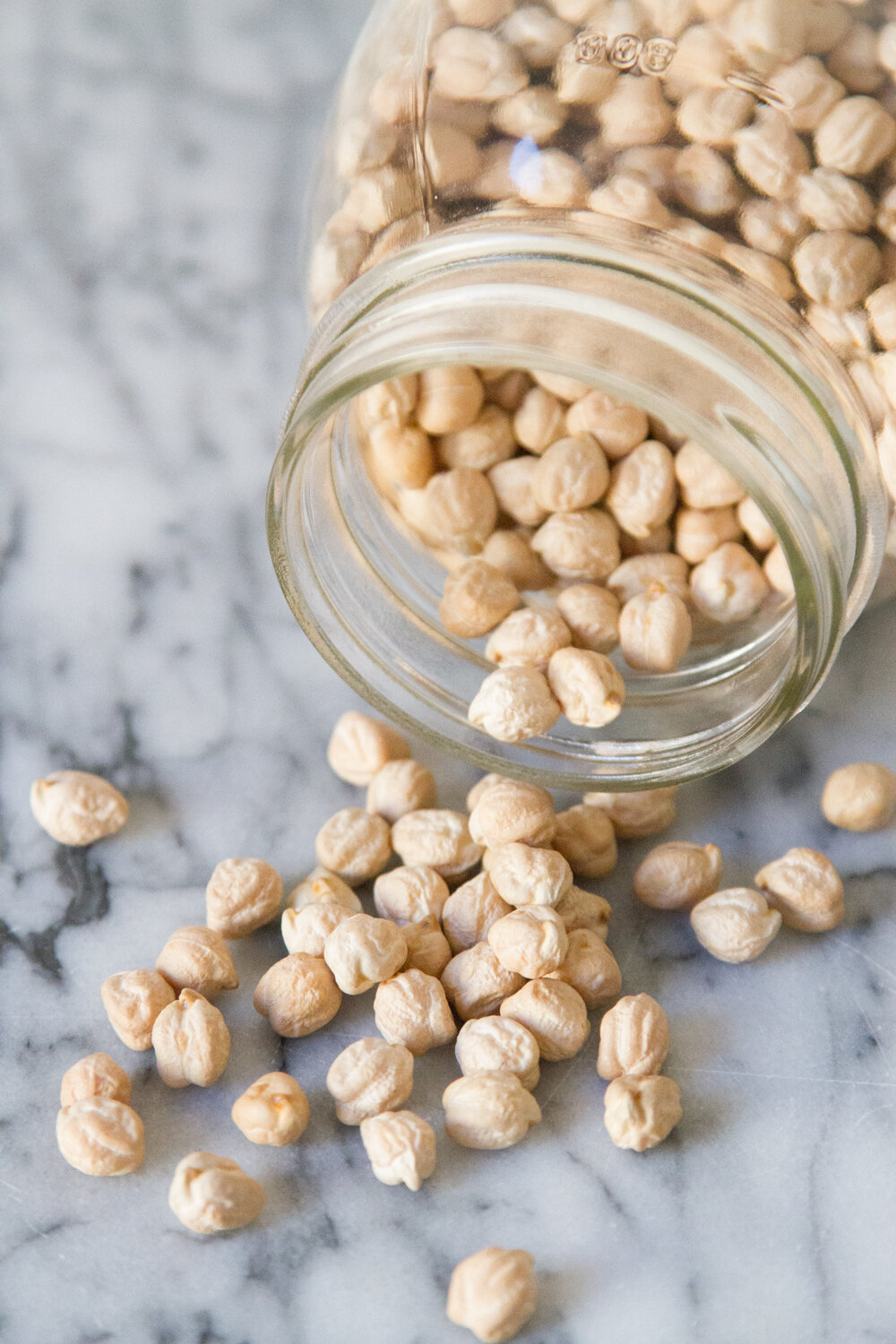
1. Buy in bulk.
I try my best to buy as many of our weekly groceries in bulk as possible, but there are always the errant cans of beans I need because I haven’t planned ahead enough to get those suckers soaking in time for dinner. This year I’m resolving to soak a weekly pot of beans so that I’m not left guiltily carrying home my weight in canned goods. On the stove today: garbanzos.
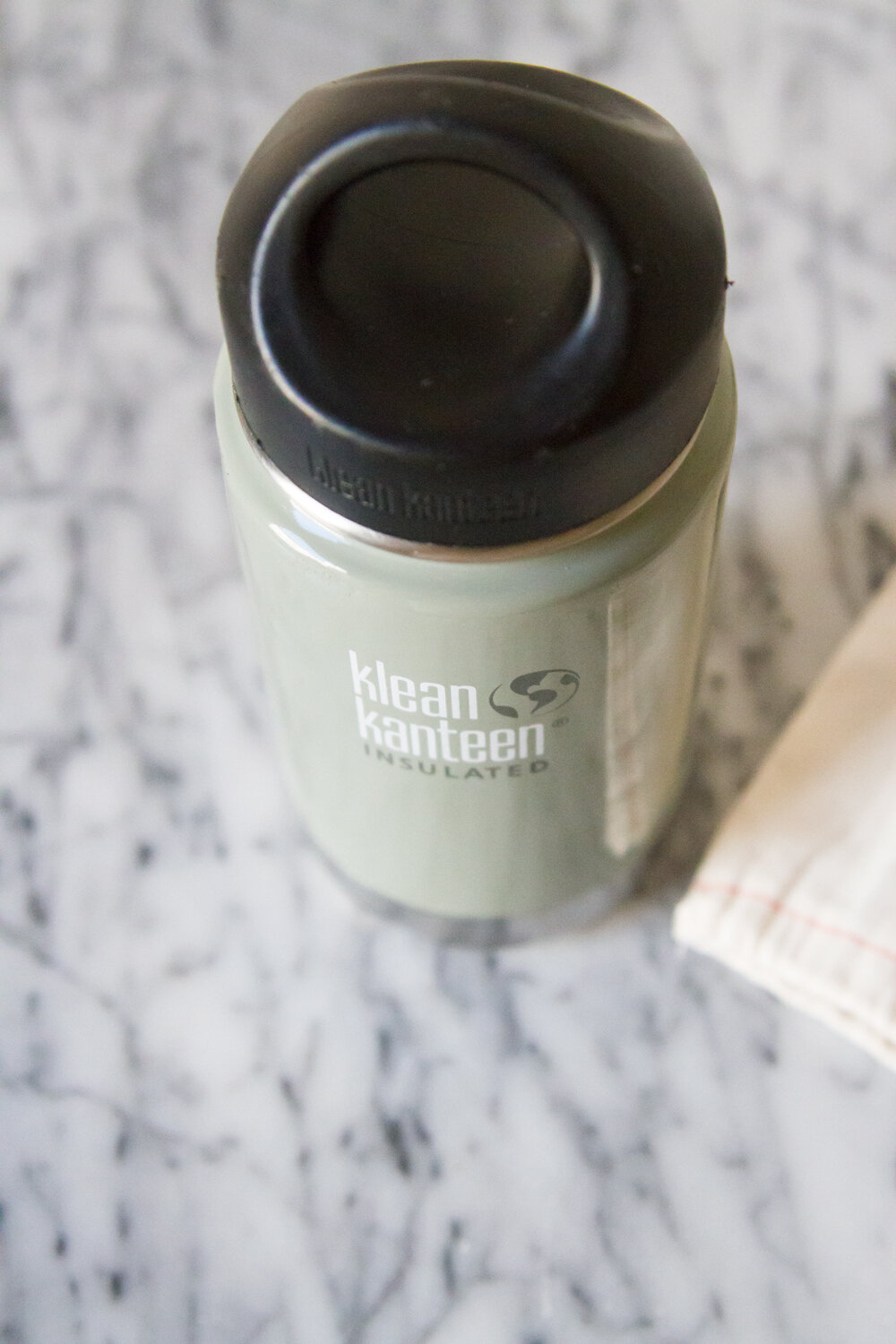
2. Refuse disposable cups.
Otherwise known as, bring your water bottle everywhere. Any bottle will do but I really love my Klean Kanteen insulated 12-ounce bottle because it keeps water cool and coffee hot and it’s small enough to pop into a bag without feeling too weighed down. Easy to wash, easy to carry. The hardest part is opting to go without when I’ve forgotten my bottle at home. Especially in the middle of along wintry walk. To work on: never forgetting.
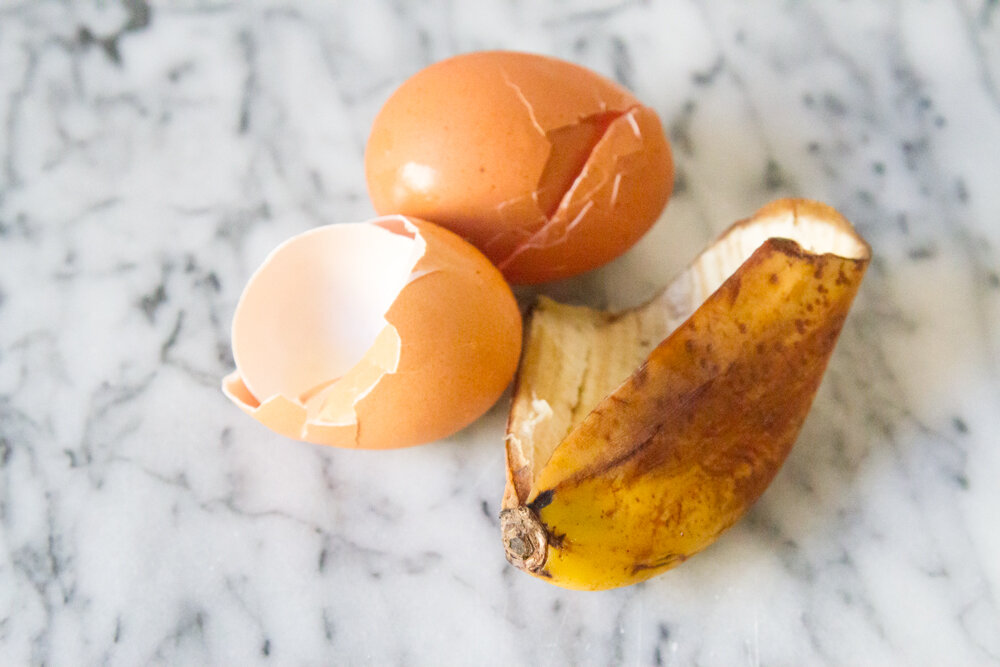
3. Compost food scraps.
We save our scraps in a large plastic bucket that we keep in our freezer. On Saturdays we bring them to the farmer’s market for composting. Some weeks more neglected and shriveled pieces of kale go into the bucket than I’d care to admit. To work on: reducing our food waste.
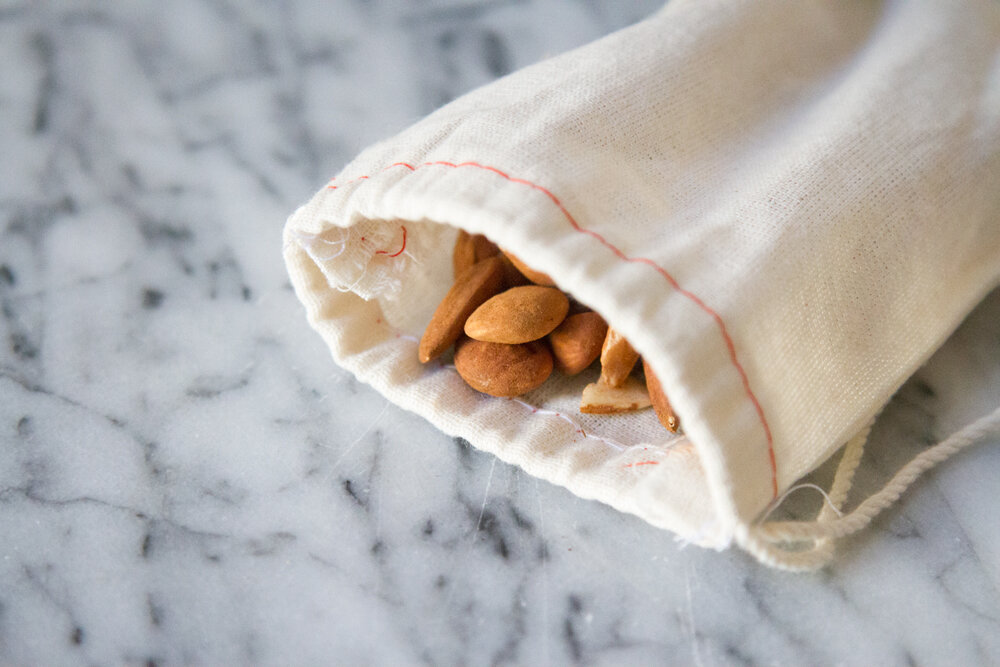
4. Bring a bag.
Big bags, small bags, any bag you can bring, do. I have a habit of keeping my market basket by the door (or, with a curious toddler now, just outside of it) for filling up with recycling. On my way downstairs, I bring it with me, unload the recycling and fill it back up with groceries. I admit I’m less good about remembering to bring a selection of smaller bags to the store for bringing home bulk items like dried beans and nuts and granola. To work on: Putting a few of them into a pouch and having them ready to go for my next trip to the bulk section.
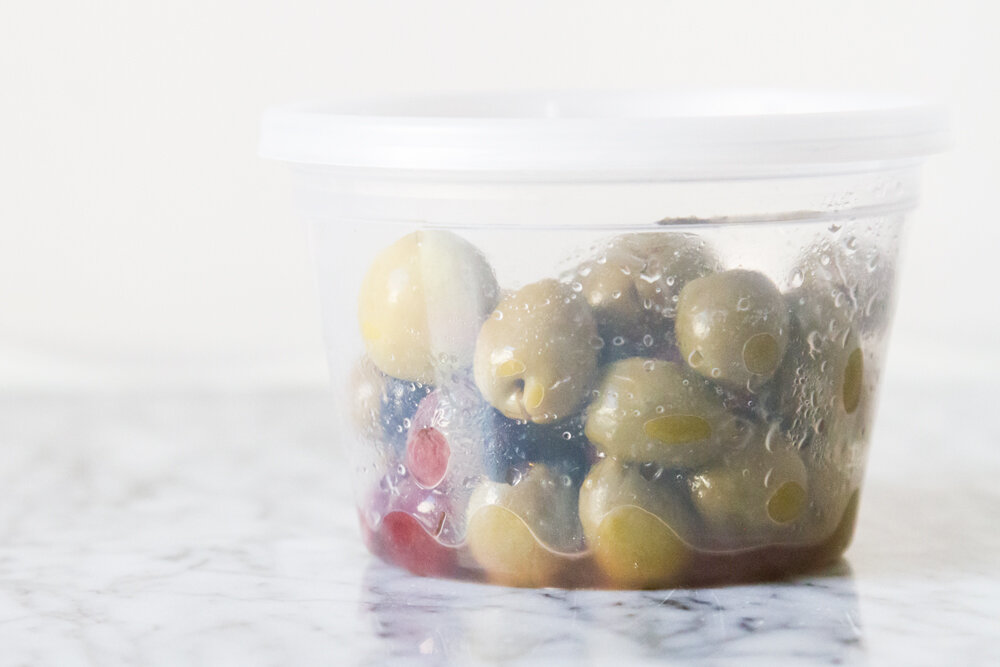
5. Fill your own container.
Peanut butter, dish soap, and maple syrup are all things that I can fill up a jar with at our grocery store. I never hesitate to hand over my empty peanut butter jar to get the tare at the front counter, or to give my water bottle to the barista, but there are other local shops and takeout restaurants where I’m more shy about bringing my own rinsed-out containers for filling. Fear of seeming like a weirdo, I guess. Or slowing down the line. To work on: #gettingoverit it the new year. I’m saving two bulk containers from the local market where I get my olive and cornichon fix and bringing them back with me. Reusing the container that they provide means I won’t have to slow down the line and I can feel much better about not sending the tub 0ut for immediate recycling.
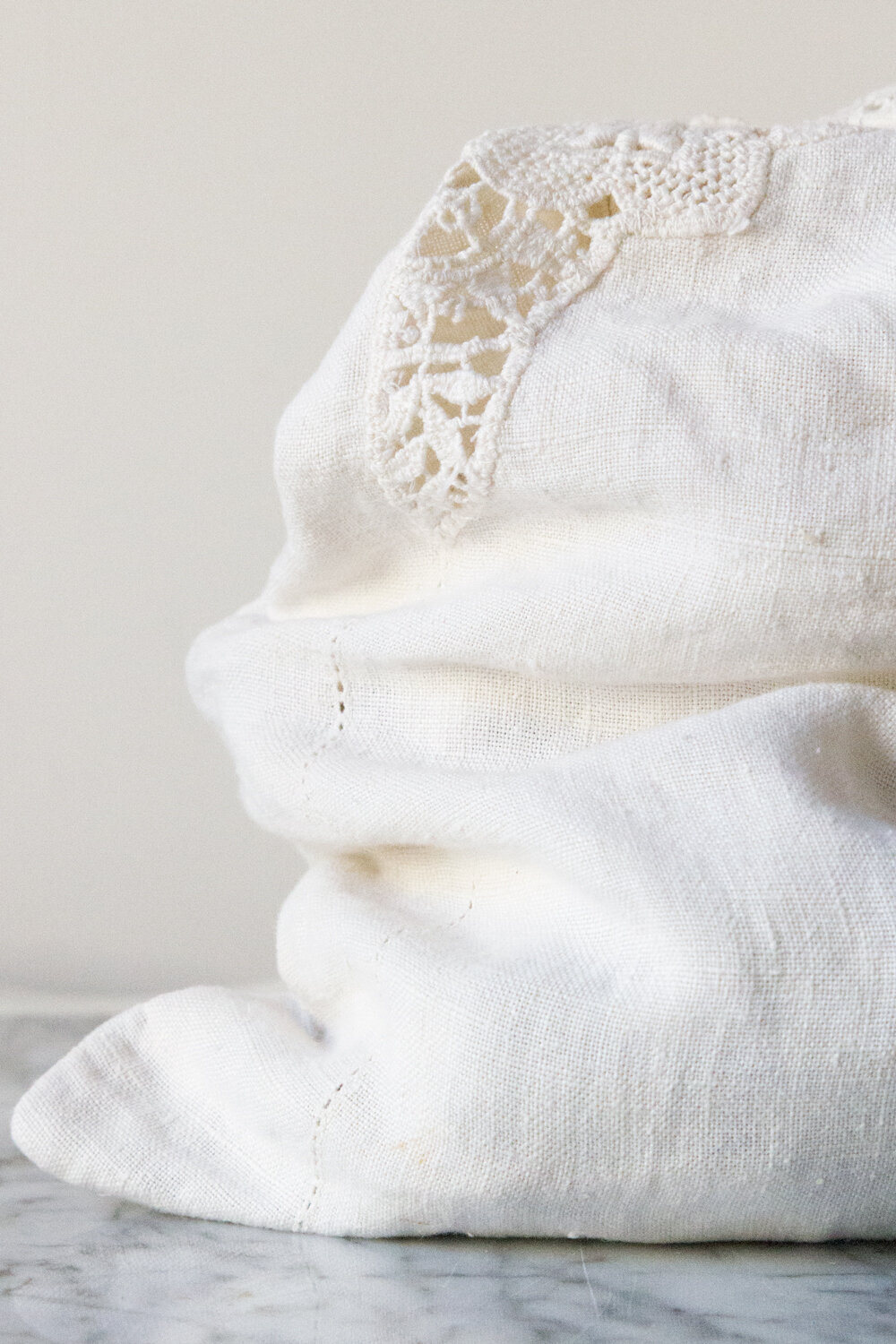
6. Say no to disposable household products.
We haven’t bought paper towels or paper plates or plastic cups or utensils for our house, well, ever. By the time James and I moved into an apartment together at 23 and 25, we were both pretty firmly onboard with an eco-friendlier approach to making a home. We keep a bag of rags in the closet for cleaning (since we don’t have a washing machine, they get rinsed and air dried before going into the hamper with the rest of the laundry). We bring lightweight washable plates and cups with us on picnics. We have a basketful of rumply linen napkins for mealtimes. To work on: Weaning myself off of sponges for counter wipe-downs. (PS. A little update to clarify that the sponges that we do use are pop-up vegetable cellulose variety. So while not perfect, they *are* a significant improvement over other synthetic sponge options with dyes and plastics, etc. And I’m still looking into it, but some folks even claim these guys are compostable. For heavy-duty scrubbing we use coir brushes and stiff-bristled vegetable brushes!)
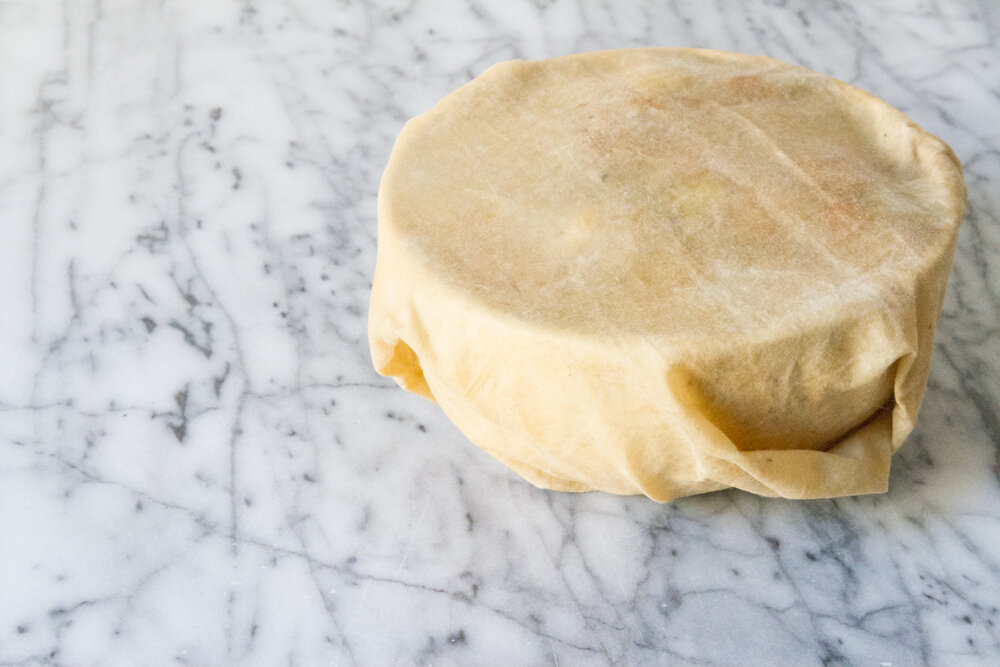
7. Find re-usable alternatives for food storage.
This goes hand-in-hand with number 6! I’ve realized that questions about food storage are a major hangup for folks hoping to reduce their reliance on disposables. But once you get in the habit, disposables like plastic wrap and tin foil are actually pretty easy to avoid. We have a few glass containers with lids that we use for packing up leftover dinner portions and a set of three stainless steel bowls with lids have been a game-changer for us in terms of keeping larger things fresh (a bowl of grapes, washed kale ready for a salad, the ever-necessary batch of cookie dough in the fridge…). And we’ve had great luck with the reusable beeswax coated Beeswrap sheets shown here. For things that really benefit from it, we do use the occasional sheet of parchment paper, which feels like a less-bad disposable alternative to the others.
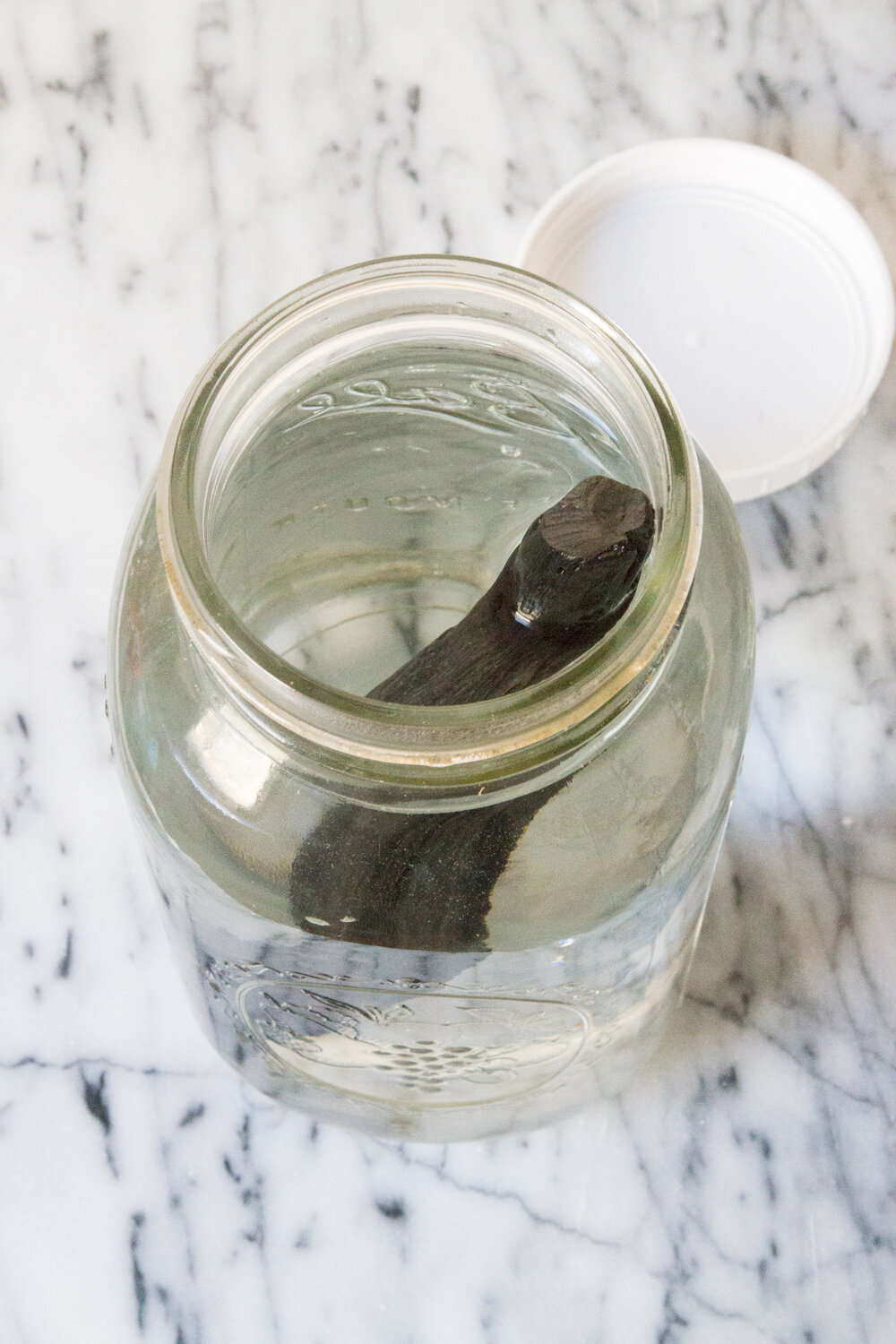
8. Purify, purely.
This one’s a little specific, but we’ve been using charcoal sticks to purify our tap water for the past two years and we’re total converts. A stick of binchotan charcoal does effectively the same work as the charcoal that’s used in a Brita filter (or similar filtration device) and doesn’t come with the inherent waste of a spent filter. (The charcoal can be broken up and added to garden soil after you’re finished with it!) (Bonus points: terrific dinner guest talking point! Also: neat looking!)
Now your turn! Any zero-waste initiatives you guys are taking this year (or always?).
In case you missed it: decluttering resolutions.

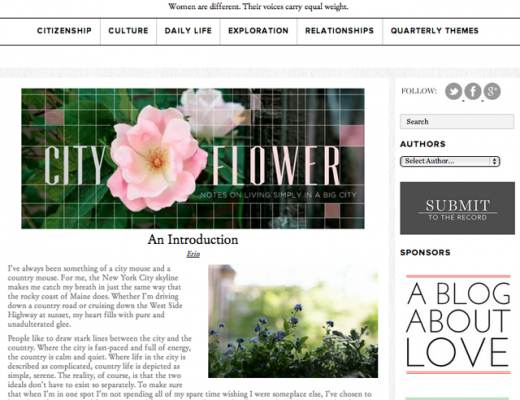
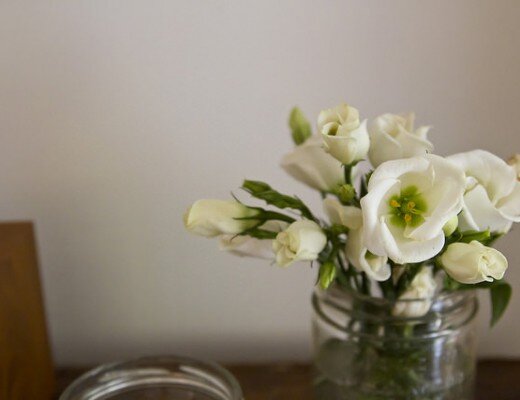
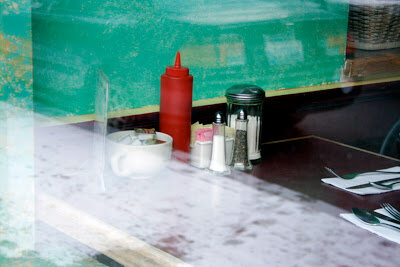
106 Comments
I cannot believe it never occurred to me to keep kitchen food scraps (and the compost container) in the freezer. I’m clearing space in my freezer TONIGHT for this. We have our own bin outside but on an ordinary day I don’t have time to take it out–so I save it up for the weekend. Given how warm this winter has been until lately I still have stray fruit flies hanging around and in the summer–it’s awful. So thank you!
I have never heard of charcoal sticks! That is awesome! I’ve been looking for a good water purifying option that isn’t crazy expensive and comes with a ton of plastic parts and packaging.
This is a really inspiring post. Thank you, Erin! I’m off to research my composting options.
Great list! Two things: 1) I’d love to ditch the sponges too, but haven’t found quite the right alternative yet. Any ideas? and 2) I always though tap water was fine to drink as is and doesn’t need the kind of filtering Brita and other companies try to sell. But I’m curious what you think and why you guys filter!
We use a machine-washable microfiber cloth. I’ve seen other people use knitted cotton cloths (ultimately compostible). I believe you can buy them on etsy.
Taste! We definitely notice a difference and can tell by the change in taste of our water when it’s time to re-boil our charcoal stick and/or replace!
A few years ago my husband and I bought 3 packages of, maybe 8, plain washcloths from Target. We use these for almost all cleaning – counter wipedowns, floor spills, pre-dinner table cleaning, basically anything one would use a sponge or papertowel for (we still use a sponge for dishes).
They don’t take up much space in the laundry, they clean up well, 8 washcloths are about the same price as 1-2 rolls of paper towels, and they look nice enough to leave on your counter/near the sink for easy reach!
These are wonderful ways to reduce waste. We’ve personally practiced all of these methods for a few years now, but I’m always on the lookout for new areas to reduce (for example, breaking my addiction to makeup-remover wipes).
Regarding sponges, we’ve been using biodegradable scrubby sponges made from walnut fibers that we can put in our industrial compost bin once they’ve fallen apart. Another tip is to sanitize your sponges in the microwave or dishwasher to prolong their lifespan.
One more thing: I find it helpful to really examine the contents of your trash bin (we use a small, bathroom-sized can for waste that must go to the landfill) to understand what types of waste you’re producing and then researching reusable alternatives. For example, I’m replacing makeup-remover wipes with cloth wipes as part of my New Year’s resolutions. Another common waste item is dental floss, and I recently found compostable silk dental floss at Whole Foods (or use a metal/rubber dental pick instead). Best of luck to everyone on their journeys to zero waste!
Check out irrigators as a substitute for floss. I have this one http://amzn.to/1MV6d54 it was highly recommended by my dentist and appreciated by my family members. Of course there’s some cost involved, but they do far better job than flossing.
As for make up removers I’ve been hoping to make my own disks, probably it’s time I should finally kick myself to actually making them. You can buy them at etsy too.
Unfortunately irrigators are no substitute for floss. They won’t get into places where the teeth are jammed pretty closely together. They can complement but not substitute floss.
I have been using raw organic unfiltered coconut oil for my cleanser/makeup remover. It works better than any other remover. It has also helped with acne, redness, and is a natural sunscreen. slather on a dry face, give a good massage. I gently coat my eyelashes, and then I place a cheap washcloth, that is very warm and steamy onto my face and let it sit there for about 30 seconds. I then start removing the oil. Depending on how much makeup I used, it might take a while and two washcloths. But my face and neck feel amazing and then I put a bit more oil under and around my eyes and im done. In winter I might need a bit more oil as moisturizer. easy!
make up remover. frozen coconut oil chunks. with warm wash rag. works wonders. I keep mine in a little pottery dish in the bathroom and extra in freezer. takes off black eyeliner and removes impurities from pores.
You can also sanitize sponges by pouring boiling water over them, let it sit in the hot water for a few minutes and then rinse them in cold water t cool them down as quickly as possibly.
For wiping counters, we use rags. My preferred materials are scrap linen, hemp, or bamboo because they are so absorbent but do not retain odors like cotton. As for scrubbing, we have used one stainless steel sponge/scrubber for close to two years – it’s an excellent alternative as it’s so long-lasting, can be sterilized easily, and inexpensive. Additionally, you could try the wooden dish wands – the heads can be replaced and composted.
Ah, yes! We use rags for all sorts of things, but there’s something about wiping down a counter (which I do, roughly, 500 times a day!) with a rag that I can’t get used to. Looking into other alternative sponge options now!
I’ve always used dish rags (wash cloths) and a scouring pad if needed. They’ve done studies on the amount of bacteria growing on sponges, yikes! Its so easy to just toss the dish rag in the wash and grab a clean one.
As for the water, I noticed once when I drew bathwater that it at a blue tint. Picked up a water filter the next day. Previous apartments have had old pipes, seemed like a good idea to treat the water to a filter.
Just thought I’d throw in my two cents worth-The reason I filter is because I live in the mountains in an old mining town. Our water is full of mine tailings that contain arsenic and metals (among other things). I just started using Pur filters because they filter out pharmaceuticals as well. I’m very concerned about ingesting everyone’s prescription drugs!
I love this blog! I thought I was an good environmentalist because I recycle religiously but now I’ll be even more careful about plastics.
I started using Norwex clothes last year and I’m in love! They’re microfiber clothes infused with silver. You wipe your counters, floors, sinks, dishes, etc., hang the towel to dry and then the silver kills all the germs. The enviro-cloth has a scouring surface for the hard to scrub stuff. It was really hard for me to believe it at first, but my Greek sis-in-law said that silver is used in Greece all the time to disinfect. I guess I was just not used to it in the U.S.
Lovely post! I’ve started making slow changes, but am no where near your level! Working on it though.
I’m curious if you could post a resource to your linen napkins/paper-towel replacements, as well as maybe explain how the charcoal placed in water as a filter works?
That’s very interesting, indeed! I love your blog. Am a complete fan.
One more thing: I’m curious which you think is more pressing: water conservation or waste reduction? I’ve done no research on this at all, but am just mulling it around in my head. I wonder what difference the energy/environmental impact is between switching to all washables vs. disposables considering in the end they both consume energy in some way.
Thanks, again for your wonderful blog!
Remember that manufacturing paper for paper towels and disposable napkins is one of the most water (and toxic chemical) intensive industries there is, so reusing cloth napkins and kitchen towels saves a ton of water in the long run. I have been using cloth exclusively for decades–I just throw them in the laundry with the rest of my clothes and do not need to run a special load for them so don’t use extra water. BTW since most meals are not very messy, my husband and I reuse our napkins for several meals (unless they are really dirty) so we are not laundering an excessive amount.
Agreed with Nancy here! Once all of the production cost of disposable items are accounted for, the less impactful choice is definitely to wash and reuse! We bring a load of laundry to the laundromat each week and include our rags and napkins in that! (We reuse napkins too–though not Faye’s. Those *always* need a wash!)
Thanks! I had no idea. It’s amazing how ignorant I (and the rest of the world) can be about these things. Which is why I follow blogs like this!
It’s hard to make sense of it all—so many options! Thanks so much for reading!
xo.
We use IKEA’s ELLY dish towels in the kitchen, and once they’re too stained, they go into the rag pile for cleaning (along with a couple microfiber cloths for dusting). They’re incredibly cheap ($4 for 4 pack) and 100% cotton. Our linen napkins were found at CB2. I love linen because it’s soft, durable, and is meant to look wrinkled–no ironing needed! We wash our rotating set of towels and napkins weekly with our peshtemal bath towels.
I live in California where saving water is always a concern, and I totally agree that using washcloths and dishtowels for kitchen duties, old cotton diapers for cleaning purposes, and cloth napkins saves a bunch of water in the long run. I just throw them in the wash with bath towels or sheets — it doesn’t make an extra load, so I’m not using extra water, detergent, or energy.
Erin, thanks for this list, it’s very inspirational. Great idea to reuse containers you get at the bulk store — most of the plastic ones can be washed and washed and washed for reuse, and I don’t have to worry about getting the tare before filling them. I just transfer to glass storage containers once I’m back at home. We live in an apartment also, so don’t have a compost pile, but I haven’t really researched the possibility of taking my compostibles to the farmer’s market. We could do the bucket-in-the-freezer as well if I can find a place to empty it! You’ve challenged me to do some research.
Sorry I missed the resource part of this question! We use mostly cut-up cotton t-shirts for rags, but have also found and used lovely cotton birdseye cotton cloths on etsy (search for reusable paper towels!). Most of our linen is from the very lovely Fog Linen. We’ve been using it for years and love it. Agreed on the comment about the rumply look adding to (not detracting from) the appeal!
Thanks!
I actually just got a linen blend duvet and am super excited about it’s messy/comfy look.
Good going!!! We’re doing most things from the list as well, only number one can be challenging. Especially if it’s been a busy week and I just pop into the supermarket here and there for this and that…
Love our charcoal sticks! The water in London tastes really bad without it too. You probably know them, but “Trash is for Tossers” and “Zero Waste Home” (love the book, too!) are my go to resources when it comes to a lighter footprint.
Happy New Year.
x
The one problem I always run into with reducing waste is the lack of places around me that allow me to buy things in bulk (I mean, bulk without waste- we have Costco and Sam’s Club!) or would refill containers for me. Perhaps it is because my town is not quite so cosmopolitan as NYC, but that option just does not exist for me. However, for Christmas I did get a bunch of great containers for storing things in my pantry and therefore reducing clutter, but none of them really solve my waste reduction issue. We do recycle basically everything that it is possible to recycle- our two large bins are absolutely overflowing. I guess we will just keep doing what we can do and that’s better than nothing!
We rarely use paper towels, though now I’m inspired to stop purchasing them altogether in favor of wash cloths and dish towels. Great post!
love it!!! fyi, it always made me so happy when customers would bring their own containers for leftovers @ the restaurant…saves me a trip to get them a box, cleaner plate to wash, etc. etc! xoxo
We started our “serious” zero waste journey last year and it is so much fun 🙂 This year, our goal is to buy second hand or make most of our clothes. Find dog food in bulk(!!!) and avoid kale/herbs/spinach in styrofoam (difficult in winter in my hood)…by the end of 2016, we hope to have a 1L mason jar as our weekly garbage bin 🙂
You are quite fortunate to have found syores that permit you to bring your own containers to fill with products. I have lucked out at an environmental shop, which sells liquid soap and household cleaners in bulk, fir which bringing your own containers is the only way to purchase these products. Bulk food stores generally prohibit customers from using their own containers and bags (for health reasons).
Hmm: I’ve never had that experience with bulk stores! Sorry to hear you’re running into that!
Thank you Erin, great post!
I have been using cloths made from hemp and bamboo for wiping in kitchen and in cleaning the house, too. The oldest is about 8 years old! 😀 So they really last for a long time. Both of the materials are naturally antibacterial too, and do not smell like a regular dish cloth does. I wash them when needed with the rest of the laundry, but not with my clothes in 40 degrees celcius, but with bed sheets in 60 degrees celcius so that they really clean well. The are made by a small finnish company Kierti, but I’m sure you can find something similar over there. And I have also knitted myself one cloth from bamboo yarn, so that is an option too!
You had great points, and next I will pay attention to the water purification, thanks for the charcoal tip.
Greetings from Finland and all the best for the year 2016!
This is beyond amazing. I work in waste management planning and try to live a waste-conscious lifestyle. It’s post like this that warm my heart and get it beating just a few ticks faster. Great goals, girl!
you and i are on the very same page. striving for zero waste here, too…
i cook bulk beans in big batches, then freeze in meal-size containers. so much healthier & cheaper than canned beans.
i’ve been using cloth produce & bulk bags for over a decade. they treat your food so much better. there is absolutely no need for plastic bags, ever. i try to always have them with me, but if i forget, i carry my items in my hands or basket. no big deal.
and don’t even get me started about single-use cups… they need to be outlawed. then everyone will remember to bring their own cup. my kids know, if they want a smoothie or a hot chocolate, they had better bring their cup or klean kanteen. we have the same bottles you do, and we also have a collection of their steel pint glasses.
love your ideas & inspriation!
Love this post. We’re doing our best, but the options for zero-waste bulk purchasing are not great in our small city. What I want to know is, does anyone know how to freeze bread without plastic? I can find all kinds of information for keeping bread at room temperature without plastic, but everyone says that plastic is still needed for freezing bread (I’m talking about unsliced sandwich bread). There’s got to be a better way.
Bea at Zero Waste Home talks about freezing bread in a pillowcase, but I have a hard time believing that works well. When I was a kid my mom and grandmothers wahed and reused the same plastic bread bags over and over for their homemade bread. Maybe sometimes the best solutions is reduce recyclables and reuse them.
I took on this resolution last year! I made a few small changes over the course of the year but it’s a continual process. Last year, I started using the beeswax wrap (although I still occasionally use tin foil/plastic wrap), began experimenting with making my own cleaning and beauty products, and started using a diva cup. I already compost, do a lot of bulk shopping, and haven’t drank bottled water in almost 10 years. This year I’m trying to be better about bringing my drawstring bulk bags with me when I go grocery shopping, reducing paper towel/napkin use, and my mom just got me silicon baking sheets so I don’t need to use parchment paper anymore. I don’t know if I can get over the convenience of sponges, but a more sustainable option is natural ones that are compostable. I just wish my roommates could get on board with reducing our household waste :/
Like you, Erin, our family has had equally good effect by eliminating the waste on the front end. By simply not buying products (paper towels, paper napkins, plastic wrap, etc.) you will find you never needed them (in their disposable form) in the first place. This an idea that we try hard to apply to anything we bring into our home whether clothing or toy, etc. Admittedly, my weakness are books (we homeschool) and a moderate addiction to house plants.
Erin, I LOVE that you are bringing more light and loveliness to this very important issue of wast reduction! Our family of 4 have been implementing these practices slowly in our home for about 5 years now and now we’re down to the smallest garbage can that Seattle city offers and most weeks it’s empty! Some small ways that we’ve been trying to dig deeper in our routines are: as you mentioned when buying bulk to bring our own bags, and now we’re also committed to not using twist ties (tying the bag in a fat knot at the top or bringing used twist ties) and instead writing down the item # on our grocery list to read out to the cashier; being super mindful of what we order online because often items come packaged in a whole lot of plastic wrap that is toxic to make and not recyclable; trying not to buy items anywhere that come packaged in plastic that’s not recyclable, or even that needs recycling as recycling also requires a ton of energy production.
It can be overwhelming once one becomes aware of our consumer habits and trying to change them, but I also think that it’s so important in the process to ask yourself what is in my power to do today? Then just do that and allow yourself to feel the liberation and happiness from that change – then ask yourself, what can I do now? Slowly, slowly.
Our family waste reduction intentions for this year: make our own diaper wipes and buy the charcoal water stick for our water!
OK. I’m extremely new to reducing waste but my husband and I tend to feel an incredible amount of guilt over our waste/trash production. So, our small family of three with a dog are going to move towards a waste-conscious lifestyle. I’m thinking about the kitchen alone, which is where most of our waste comes from. What do you do about things like ranch dip or mayo/mustard, etc that comes in plastic bottles? These things aren’t refillable. Things like lunch meats/cheese, even purchased from the deli counter, always come in tons of wrapping/plastic – how do you avoid this? Perhaps I need to purchase a book or something? I have no idea where to even begin! Any suggestions?
Hi Amanda! You can certainly look into a book. (Zero Waste Home by Bea Johnson might be a good starting place if you’re looking for specifics!) But for me, part of this has just been about truly changing purchasing habits across the board: Seeking out condiments in glass jars instead of plastic ones, asking at the local deli counter if you can bring your own container instead of getting things bagged up, etc. It definitely takes a little more work and a little getting used to, but it’s doable! Little by little!
Erin, I really, really appreciate what you are doing, especially in these last two posts. I think it helps to read what others are doing and it is also helpful to read alternatives to things I am already doing. I do have a question about sponges — a science researcher at a large university told me years ago not to use sponges because they harbor something {don’t remember term} and using a sponge only spreads that ‘something’ all over your kitchen, even if you rinse after use. His take was, if you put it in the dishwasher after every use you’re OK; if not, stop using them. Has anyone else heard that? I haven’t had a sponge in my kitchen for 34 years because of him! On another note, I started reading your blog in October, and I’ve been soooo inspired!
I pre-ordered your book a while ago and just got a note from Amazon that I’ll get it on the 18th! So I wrote back and said, ‘why not sooner?’ I’ll see what they say! Keep up the lovely, hard work — it is appreciated!
Oh, well. I know lots of people are anti-sponge for fear they harbor bacteria. It’s kind of muscle-memory for me. I grew up using them and have a hard time letting go;)
We switched to charcoal sticks about a year ago because of your recommendation and we LOVE them. My husband can be a bit reluctant on some of my zero-waste conversions (he tolerates my homemade laundry or dish detergents, but just barely), but he loves the charcoal. It is ABSOLUTELY a dinner guest talking point and people often comment on the great taste of our water. So- thank you! And I’m glad to see others in the comments saying they’re going to give it a try as well!
One other addition I thought of for your list is one I am working on too- quite similar to your resolution to bring your Kleen Kanteen with you everywhere: attempt to always carry a handkerchief. We only use cloth napkins and rags in our home, but if I don’t have one in my purse/bag, I often revert to disposable while out. A sturdy handkerchief that can stand in as a tissue or napkin in public is SO useful.
Great post. Can you recommend or link to the aluminium bowls *with lids*?! Thanks!
Sure! We have this very affordable set.
And just to clarify: they’re stainless steel, not aluminum!
Do you make your own yogurt? My clutter item is yogurt containers. I try to wash them out and save them for food storage, but they keep piling up. I recycle them, but still – it seems wasteful. As far as I know there’s no way to avoid that unless you simply don’t buy yogurt.
We don’t make our own yogurt, but we do always buy the large tubs instead of the individual serving sizes. And we recycle. One day I’d love to try my hand at making my own!
Thank you, for sharing all these
helpfil tips. I cannot wait to try
the Charcoal. I am good at using
old tee shirts for rags, etc, I wish
oh I wish I could stop using paper
towels, hubby does not like or use
them, they come in handy for Poochies
etc. For our mesls always cotton or
linen napkins.
We shop in bulk, just now started to
leave clorh bags in the truck, always
forget them.
I love ya blog!!!
Thank you
Thanks for more inspiration! I think it may be time to swap my brita for the charcoal sticks.
Question: what size jar do you find works well per stick?
Question 2: I have toyed with ridding myself of paper towels since you first wrote about it. However, I find that lettuce, herbs, other lovely veg keeps much better with a damp paper towel wrapped around. Any suggestions on how you store your veg to keep them super fresh and crisp without paper towels?
Thanks!
A damp linen or cotton dish towel does the same trick! (We use a small pitcher and a liter-sized mason jar like the one in the photo! I find it helpful to have two vessels going so that one is always fresh!)
How about toilet paper, or old tubes of toothpaste? Great blog!
Oh man, indeed. There are about a million things to improve on. You could try a tooth powder instead of paste!
You can make your own toothpaste (there’s a variety of recipes online) w/simple ingredients like baking soda, essential oils, etc. and store it in a reusable container. If you prefer purchasing toothpaste, Lush makes powdered tooth tablets that are sold in cardboard containers (100% recyclable). As for TP, you can purchase paper wrapped rolls at Whole Foods and other health food stores, or in bulk from restaurant/hotel supply stores (really inexpensive).
We like Tom’s of Maine products. On their toothpaste tubes they give information about recycling the empty tubes (and other hard-to-recycle items) through TerraCycle. I know that’s not actually zero-waste, but saving up a box of stuff I can’t put in my recycling bin (like a dried-up marker or an old #6 plastic jar from which we finally used the last petroleum jelly I’ll ever buy) to send to TerraCycle is the next best thing.
http://www.tomsofmaine.com/terracycle
I LOVE the charcoal sticks. I purchased some in October and they are amazing! I keep a small pitcher in my fridge with purified tap water and it tastes so much better. I also keep one in my water bottle for when I fill from a drinking fountain or tap while I’m out and about. I know it doesn’t filter that quickly, but it definitely is better than not having it. Plus in my glass waterbottle, people always ask, “What is that?” 😉
It’s funny what things different people are hooked on using. I have never liked sponges, so I never use them. However, I would like to get rid of paper towels and can’t quite seem to. I’m good with cleaning up spills with cloth, but I want paper towels to wipe out greasy pans. My paper towel consumption has gone way down because I’m very mindful of when I use one, but they are still there in my kitchen.
Any ideas for dealing with packaging waste? This is one of my pet peeves. I get a lot of my household goods delivered from Amazon to save time and money, but the tradeoff is a huge amount of waste.
TerraCycle (see my comment above)
Oh. . . plus I reuse as much of the cushion packaging as I can when I send gifts to far-flung relatives.
I do many of the things listed above, and I’m lucky to live in a town close to my grocery coop, where I always bring assorted jars for spices, pasta, oats, peanut butter, syrup, dish detergent, etc. Any of my husband’s old undershirts become rags, and we clean with baking powder and vinegar. One thing I’m working on is learning to use my Diva cup. It takes some getting used to, but it’s comfortable, virtually waste-free compared to tampons, and has no harsh chemicals. It is $35 and lasts for one year, versus spending about $120/year on tampons, which are often bleached cotton and come in a ton of packaging.
Undershirts as rags are such a good idea! Has the Diva Cup changed their advertising/advice in terms of replacing it every year? I used my first one (before I had babies) for about 7 years, and it was still working well. I’d boil it in water after every cycle.
I don’t remember if the packaging on my Diva cup said anything, but I met someone who works there and she said it’s about a year, since the plastic can break down. As long as it’s holding up, though, I think it’s more than fine! It does take some getting used to, but now I can’t believe I waited so long!
Maybe TMI: I’ve been using my diva cup for 10 years now, boiling it after each month. Still going strong!
More info about the charcoal sticks please!!!
Advice on napkins that wash well and won’t look stained, bearing in mind I have a preschooler who eats her body weight in ketchup weekly?
Use ones with colour and/or pattern, not white. We have vintage tea towels cut in half and hemmed.
do you find it hard to pour from the big gallon wide mouth jar?
Nope! (It’s not the same as a pitcher, but we haven’t been bothered by it!)
Hm wonder if I can fit one in my fridge door. Thanks for the tip!
That’s where we keep ours!
ah I was thinking they were the huge Ball jars but I think now I see they are the quart ones. Thanks!
Ah, no! They are huge ones—not 1 liter! 64 ounces!
Just wondering what people here use for garbage bags?
We use the compostable trash bags in the kitchen, and reuse bread bags for a small wastebasket in the bathroom.
You inspired me to dig out my grandmother’s linen napkins. When you said I didn’t have to iron them, I was in! It feels doubly good to use something special that’s been languishing in a closet and to help the environment just a little. We use unique napkin rings that identify whose napkin is whose. Thank you for the inspiration!
I love that zero waste is becoming mainstream. I’m nowhere near as zero-waste as I’d like to be, but I’ve been on the journey for ten years and keep making progress. It makes it easier now that zero-waste products and cooperatives and bulk stores are more available than ever. I still have a long way to go. This year I would like to invest in some metal straws and carry them with me. I would like to also remember bringing my water-soluble crayons with me to mark my tare and product numbers directly on my fabric bags rather than using the plu stickers available at my local co-op. I would also like to work on purchasing a whole lot less, and when I do have/want to buy something, I look at secondhand options first. Here’s to a more sustainable 2016!
I found that our zero waste practices flew out the window when we had a child. We could not have afforded compostable diapers and only used the cloth diaper service for the first six months. After that we threw away so many diapers for years that I tear up thinking about it. Now it’s only the diaper wipes that are thrown out and we are getting back on track again. Thank you Erin for the reminders. ^_^
In regards to #5 many restaurants are not allowed for you to bring in your own containers for leftovers or food purchases. It can be against the local health codes.
True! But many will! We brought our glass containers to a sushi restaurant last week!
Some really great ideas to think on, thank you! We stopped the paper napkins, plates and cups years ago and I bring my Tervis tumbler with me everywhere since it works for hot and cold (looking for a non-plastic alternative that can work for both as well … ). Last year, my daughter crocheted me face-wipe disks that I can use with my DIY makeup remover/face cleaners and they fit nicely in a little Fido jar. We’ve also eliminated tea bags and packaging by going bulk there (don’t glass jars look so much better?!) Last summer I cold-brewed my coffee in reusable bags which was heavenly (I’m almost ready to get rid of the coffee maker entirely). I’ve been trying to buy bulk more often, but our lack of cooking really impacts our waste, so I might try to take some reusable containers for take-out and see who will allow it. Because we don’t cook much, composting is probably not too helpful, although I suppose banana peels can add up:)
These are such great tips! And like many here I love the charcoal and excited to try it out. I was looking for simple solution to purify my water without getting a Brita that takes ups space and plastic.
I’m trying to reduce paper towel use but my weakness is in the bathroom — like cleaning the toilet seat, etc. I have a potty training boy … 🙂 so I prefer to wipe, disinfect and toss. Do you use rags for cleaning the toilet as well?
I do! I just rinse in hot water immediately, hang dry, and then toss in the hamper to be washed again.
This is the best round up ever! Now, if you have any advise on shower curtains, I would be highly appreciative. In the past I bought the plain white ones from Ikea, they’re only 5 Euros but get moldy quick and the cheap plastic is made in a way that it will deteriorate after 2-3 years. I was considering a cotton curtain and coating it with wax but I don’t think with warm water this will work out. Any ideas?
Yes! I’ve been using this exact same clear plastic curtain ever since I wrote this post and realized I just had to toss it in the washing machine to get it clean! Some washes it comes out cleaner than others, but it’s sparkly more often than not!
Ah, thanks! I hadn’t figured out a good way to handle shower curtains. . . great info!
Great goals for the new year! I also aim to reach a zero-waste kitchen! I think that it is a shame to have food waste and to let so much organic waste reach the landfills. Composting is such a great solution for kitchen scraps. I try to use all the food that I buy and if I can’t eat something – I put it in the freezer. Thanks for sharing this lovely solutions!
Great post – I loved reading your experience so far and what you want to work on. My family has (publicly, oh my what were we thinking) committed to “going zero waste” in 2016. The coolest thing I’ve found – which might be also because I’m pretty extroverted – is that I talk to people more. My barista when I hand over a reusable mug (it is interesting to me how many reusable mugs coffee shops sell but yet I’m typically the only one in line with one), hand over a glass container to be filled at the deli counter with cheese or meat, use reusable bulk bags. I also have a toddler in tow – a 14 month old girl – and I find that it might be a little more difficult but in some ways its for her that we’re choosing to now live our life this way. And we certainly don’t feel deprived. We still enjoy crackers, pizza, delicious cocktails, etc. We just go about getting those things a little differently (aka: make everything from scratch, get refillable growlers of booze, etc.) Congrats on moving in the zero waste direction – can’t wait to follow along.
where is your marble board from?
Sûr la table!
I read this post when you originally posted it at the start of the year and have just returned to it to jog my memory – had to leave a comment to say how much it inspired me. I’ve swayed towards the eco-friendly for years and gave up meat as a teenager for environmental reasons, but I could do so much better! This post was so useful -am already doing many of the things, but now switched to dried beans (don’t know why I didn’t think of doing this sooner!) and am researching food co-ops where I can buy in bulk, though already shop from greengrocer’s where I can fill my own bag with fruit/veg. Just wish I could find somewhere in London where other foodstuffs could be bought in bulk. Any ideas, anyone?
Thanks Erin for such a great post 🙂
The Bulk app has listings of bulk stores all over the world.
Psst: Here’s a link to the Bulk App.
Here’s a link to contribute to their ongoing fundraiser effort!
Donated last week. I hope they hit their goal!
Seriously loving this series! I’m wondering if anyone has tips on how to store pieces of produce that are partially cut, like half of a lemon or a cucumber, for example. I’m trying to get away from ziplocs, but finding myself at a loss for storing little bits like that. A whole container seems excessive and tin foil makes me think it’ll get slimy. Any suggestions? Thanks!
We really, really love Bee’s wrap for this kind of thing! But we’ve also had luck getting a few little stainless steel containers that are tiny and helpful for all kinds of things!
Awesome. I’m definitely going to order some ASAP! Thanks for the reply!
Was shopping for beeswax covers and stumbled upon this project. Appealed to me since it seems, from reviews I read, that beeswax covers need to be replaced every few months or at least yearly if used often. Just made my first cover with an old sheet and beeswax pellets I had from making lip balm. Amazing!
http://myhealthygreenfamily.com/blog/wordpress/plastic-wrap-alternative-diy-beeswax-cotton-wraps/
what plastic container do you use for your compost container? Hudson River Park just started offering compost collection and I am psyched to get started!
Ours is a big clear plastic container with a lid (and blue handle!) that James got at The Container Store!
Thank you!
I’ve been looking for a way to replace my Brita filter, but still have purified water! So excited to try your last tip, thank you!
Comments are moderated.